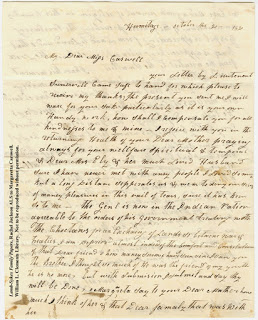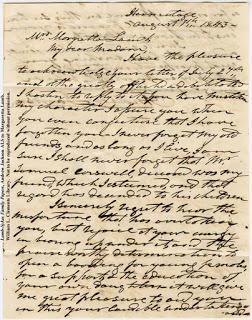Guest post by Katelyn Jedro
Katelyn Jedro, former graduate student at Wayne State University’s School of Library and Information Science (grad. Spring 2013), completed her 2013 winter semester practicum at the William L. Clements Library. She confronted the challenging task of arranging and describing the papers of the prominent Lamb and Sykes families of Philadelphia. The collection revolves around the 19th century financial and business activities of Margaretta Lamb née Carswell, her husband Lemuel Lamb, and their son-in-law Robert Wharton Sykes. In addition to extensive financial records, the collection includes approximately 245 letters to and from family members. One of the many small groups of notable correspondence is six letters between Margaret Carswell, Margaretta Carswell, Rachel Jackson, and General Andrew Jackson. The Jacksons were personal friends of Margaretta’s parents, Samuel and Margaret Carswell.
 |
| Rachel Jackson ALS to Margaretta Carswell; October 20, 1820. Hermitage. |
On October 20, 1820, Rachel Jackson wrote to the young Margaretta that her husband “The Genl is now in the Indian Nation agreeable to the orders of his government treating with the Choctaws for an Exchaing of Lands so betwene war & treaties I am Deprived almost indeed of the comfort and consolation of that Dear friend.” Later in the same letter, she wrote “I have this moment receid Letters from my Dear absent friend he has made a good treaty with that nation of Indians he has obtained six millions of Land for the government thus says He Ends my Diplomacy, but I am bereaved of almost Every Earthly comfort Its nearly Eight weeks since he Left home.” With the Treaty of Doak’s Stand, signed October 18, 1820, the Choctaw tribe signed over a significant portion of their land holdings in central and western Mississippi.[1]
Another prominent historical event mentioned in these letters is the fall of the Second Bank of the United States, which was liquidated in 1841.[2] Margaretta’s father served on the board of directors for the bank, and she inherited stock upon his death. In a letter dated in 1843 she wrote to Andrew Jackson:
“It has been our misfortune to live in the atmosphere of the United States Bank & you are probably aware that this institution was a pet of my Fathers but not under the administration of Nicholas Biddle & Co. know the paralyzing effect it has had throughout our country & sad very sad have they been our Bank & our city. We like others out of business & living on income have met with very heavy losses & although we have a good deal of real estate yet it does not yield an income sufficient for our family to live on neither can we sell it with a sacrifice of from one half to two thirds and having a family of nine children seven daughters & two sons I do not feel it right to make any such sacrifices.”
To help offset the family’s losses, she proposed to establish a boarding school for girls at the Lamb home on Chestnut Street. The former President responded to her letter on August 7, 1843, commended her for her intent to start the school, and promised to spread the word amongst his female relations. Margaretta’s letter to Jackson seems ironic in that her recipient was instrumental in preventing the re-chartering of the bank in 1836.
 |
| Andrew Jackson ALS to Margaretta Lamb; August 7, 1843. Hermitage. |
Many additional subjects of interest are contained in these letters, including Rachel Jackson’s references to the construction of the Hermitage mansion and to religious revivals in Tennessee (letters dated in 1820).
The finding aid for the Lamb-Sykes Family Papers may be found here: Lamb-Sykes Family Papers Finding Aid.
Footnotes:
1. Everett, C.S., “Doak’s Stand, Mississippi,” in Treaties with American Indians: An Encyclopedia of Rights, Conflicts, and Sovereignty (ABC-CLIO, 2007), 416-417.
2. Hammond, Bray, “Jackson, Biddle, and the Bank of the United States,” The Journal of Economic History, 7, no.1 (May 1947): 15.
